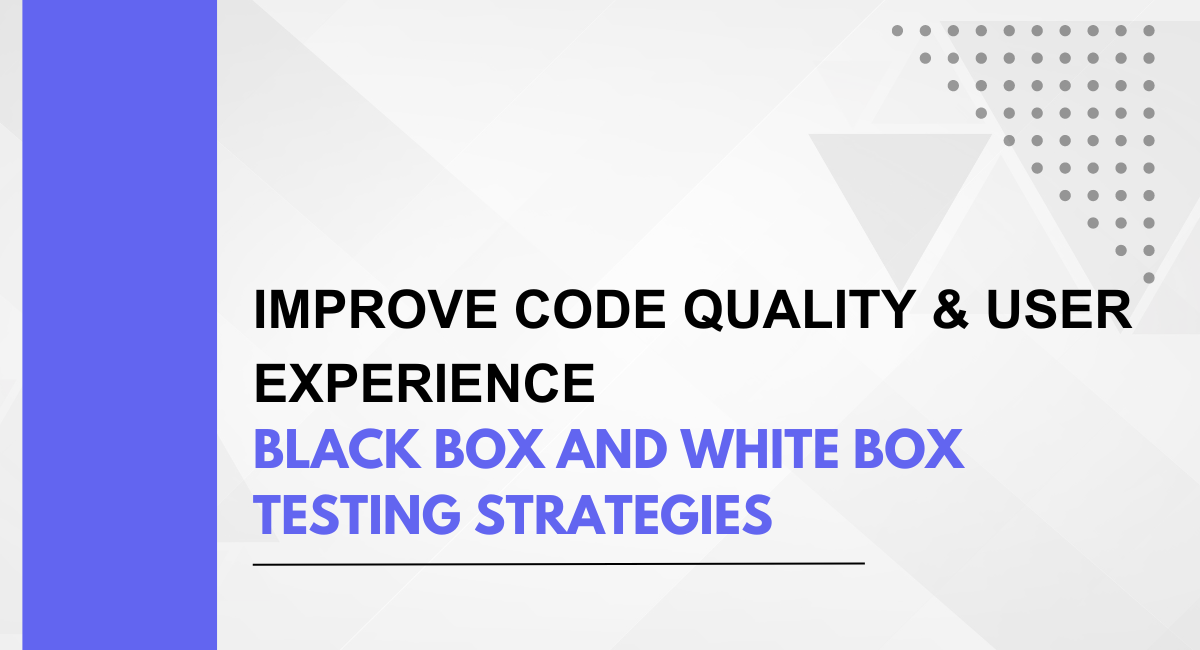Testing is a fundamental pillar in the software development lifecycle, serving as a safeguard against defects and vulnerabilities. A robust testing strategy not only helps identify and rectify issues early in the development process but also contributes to building a resilient and high-performing application. Two prominent testing methodologies, Black Box and White Box testing, play crucial roles in this endeavor by offering distinct approaches to validating the functionality, security, and performance of the software.
Understanding Black Box Testing
Definition and Explanation
Black Box testing is a software testing methodology where the tester assesses the functionality of a system without having any knowledge of its internal code or structure. The focus is solely on the inputs and expected outputs, treating the software as a "black box" where the inner workings are not visible. This approach is designed to evaluate the system's behaviour based on its specifications, requirements, and intended functionalities.
Characteristics and Benefits of Black Box Testing
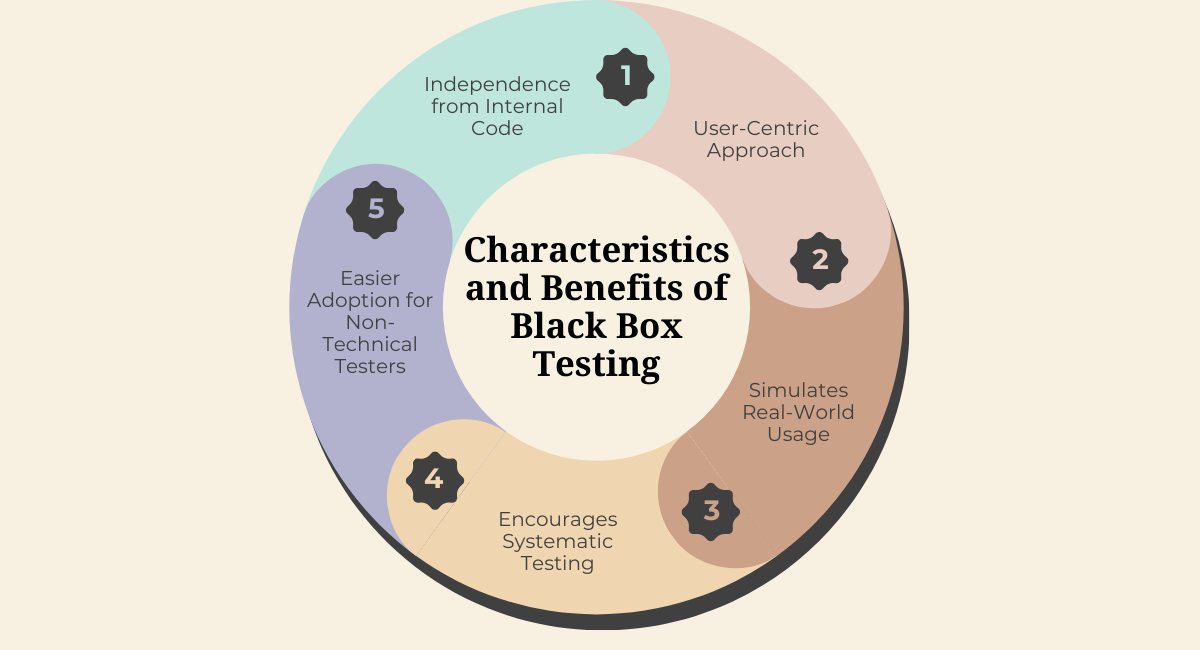
Independence from Internal Code:
Black Box testing emphasizes the external behaviour of the software, allowing testers to assess the application without any knowledge of its internal code. This independence promotes an unbiased evaluation of the system.
User-Centric Approach:
Since Black Box testing focuses on the user's perspective, it is effective in validating whether the software meets user expectations and functional requirements. This makes it a valuable method for ensuring a positive user experience.
Simulates Real-World Usage:
Black Box testing simulates real-world scenarios by examining how the software responds to various inputs and usage patterns. This helps identify potential issues that users may encounter in practical situations.
Encourages Systematic Testing:
Testers can design test cases based on functional specifications, requirements, and use cases, ensuring systematic coverage of the software's functionalities. This systematic approach enhances test coverage and reduces the likelihood of overlooking critical scenarios.
Easier Adoption for Non-Technical Testers:
Black Box testing is often more accessible to non-technical testers or those unfamiliar with the internal codebase. This makes it a versatile testing method that can involve multiple stakeholders in the testing process.
Examples of Scenarios Where Black Box Testing Is Particularly Useful
User Interface Testing:
Evaluating the functionality and usability of the user interface without delving into the underlying code.
Integration Testing:
Verifying the interactions between integrated components without examining their internal structures.
System Testing:
Assessing the entire system's functionality as a whole, ensuring that all components work seamlessly together.
Acceptance Testing:
Validating whether the software meets the specified requirements and is ready for user acceptance.
Compatibility Testing:
Ensuring that the software works correctly across different environments, devices, and browsers.
Challenges and Limitations of Black Box Testing
Limited Depth of Testing:
Black Box testing may not uncover certain defects related to the internal logic or coding errors, as it does not assess the inner workings of the system.
Incomplete Test Coverage:
While systematic, Black Box testing might miss some paths and scenarios within the code, leading to insufficient test coverage.
Dependency on Documentation:
Effectiveness is often reliant on the accuracy and completeness of external documentation, which may only sometimes be up-to-date or comprehensive.
Inability to Test Structural Flaws:
Black Box testing may not be suitable for uncovering issues related to code structure, algorithms, or performance bottlenecks.
Difficulty in Replicating Complex Scenarios:
Replicating complex real-world scenarios may be challenging, potentially leading to oversight of critical use cases.
Despite these limitations, Black Box testing remains a valuable and widely used testing methodology, mainly when focusing on user experience, requirements validation, and high-level functional testing. In combination with other testing strategies, it contributes to a comprehensive quality assurance process.
Exploring White Box Testing
Definition and Explanation
White Box testing, also known as Clear Box testing or Glass Box testing, is a software testing approach that examines the internal workings of a system, including its code, logic, and structure. Testers who perform White Box testing have access to the source code and use this knowledge to design test cases that evaluate the correctness of individual functions, paths, and conditions within the software.
Characteristics and Benefits of White Box Testing
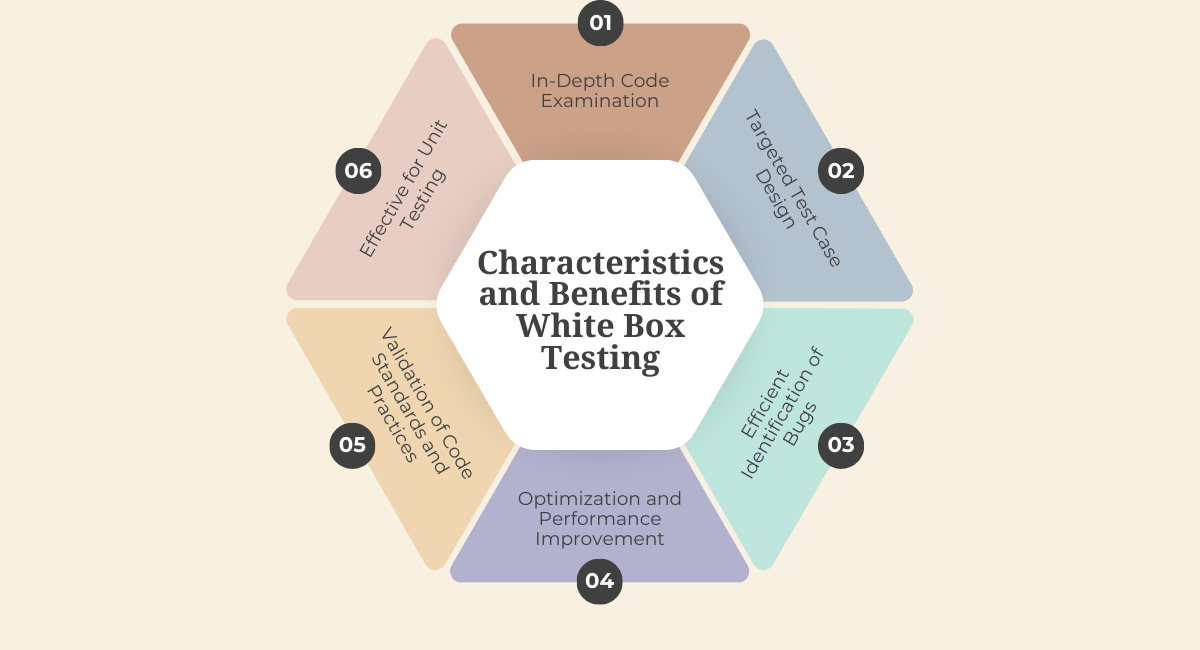
In-Depth Code Examination:
White Box testing involves a thorough analysis of the internal code structure, logic, and algorithms, enabling testers to identify and address issues at a granular level.
Targeted Test Case Design:
Testers can create test cases based on specific code paths, conditions, and statements, allowing for targeted testing and coverage of critical components.
Efficient Identification of Bugs:
Since testers have insight into the internal code, White Box testing is efficient in identifying coding errors, logical flaws, and potential security vulnerabilities.
Optimization and Performance Improvement:
White Box testing can help optimize code for better performance by uncovering inefficiencies, bottlenecks, and areas where code can be enhanced.
Validation of Code Standards and Practices:
This method ensures that the code adheres to established standards, coding conventions, and best practices, contributing to maintainability and readability.
Effective for Unit Testing:
White Box testing is particularly beneficial for unit testing, where individual components or functions are tested in isolation to ensure their correctness.
Examples of Scenarios Where White Box Testing Is Particularly Useful
Unit Testing:
Verifying the correctness of individual functions, methods, or modules to ensure they work as intended.
Integration Testing:
Assessing the interactions between integrated components, focusing on data flow and communication between modules.
Path Testing:
Examining different paths, conditions, and branches within the code to ensure comprehensive test coverage.
Security Testing:
Identifying and rectifying potential security vulnerabilities by scrutinizing the code for weaknesses and possible exploits.
Code Review Process:
Integrating White Box testing into the code review process to ensure adherence to coding standards and identify issues early in development.
Performance Testing:
Analyzing the code for performance bottlenecks, memory leaks, or other inefficiencies that may impact the application's performance.
Challenges and Limitations of White Box Testing
Dependency on Code Access:
White Box testing requires access to the source code, which may not always be feasible in specific scenarios, such as third-party components or closed-source systems.
Assumption of Correct Specifications:
The effectiveness of White Box testing relies on accurate and complete specifications. If the specifications are correct, the testing may uncover only some relevant issues.
Complexity and Time-Consuming:
Analyzing and testing every line of code can be time-consuming, especially in large and complex systems, making it challenging to achieve comprehensive coverage.
Potential Bias from Testers:
Testers with knowledge of the internal code may unintentionally develop test cases that align with their assumptions, potentially overlooking scenarios that others might discover.
Limited Focus on User Experience:
White Box testing primarily addresses internal code aspects and may not be as effective in identifying issues related to user experience and usability.
Despite these challenges, White Box testing is crucial for ensuring the robustness and reliability of software systems, especially in contexts where a deep understanding of the internal workings is essential for achieving high-quality results. When combined with other testing methodologies, it forms a comprehensive quality assurance strategy for software development.
Code Quality Improvement through Black Box Testing
How Black Box Testing Contributes to Overall Code Quality
Black Box testing, while primarily focused on validating the external behaviour of software, plays a significant role in enhancing overall code quality. Its contributions extend beyond identifying functional issues and user experience concerns. Here's how Black Box testing contributes to code quality:
Requirements Validation:
Black Box testing ensures that the software meets specified requirements, validating that the code aligns with the intended functionality outlined in the project documentation. This helps prevent divergence between the planned and actual system behaviour.
User-Centric Evaluation:
By simulating real-world user interactions, Black Box testing provides valuable insights into how users experience the software. This user-centric evaluation helps identify areas where the code may need improvements to enhance usability and meet user expectations.
Identifying Integration Issues:
Black Box testing is effective in uncovering integration issues between different components or modules. Testing the system as a whole helps identify and resolve problems related to the interaction of various parts of the codebase.
Stress Testing for Reliability:
Through Black Box testing, the software can be subjected to stress scenarios, allowing testers to observe how the code handles unexpected inputs, high loads, or adverse conditions. This helps improve the reliability and robustness of the code.
Security Validation:
While not its primary focus, Black Box testing may reveal security vulnerabilities by assessing the system's response to different inputs. This contributes to the identification and rectification of potential security risks in the code.
Case Studies or Examples Showcasing Successful Code Improvements with Black Box Testing
E-commerce Application:
A Black Box testing initiative on an e-commerce platform revealed inconsistencies in the checkout process. By simulating various user scenarios, the testing team identified code issues related to order processing and payment handling, leading to code modifications that significantly improved the application's reliability and user satisfaction.
Healthcare Software:
Black Box testing of a healthcare management system exposed issues in data validation and user access controls. The findings prompted a code review and subsequent enhancements to ensure data integrity and compliance with regulatory requirements.
Financial Software:
In the case of financial software, Black Box testing uncovered discrepancies in calculation algorithms that could potentially lead to incorrect financial reports. The code was refined to address these calculations accurately, enhancing the software's precision and compliance.
Best Practices for Implementing Black Box Testing to Enhance Code Quality
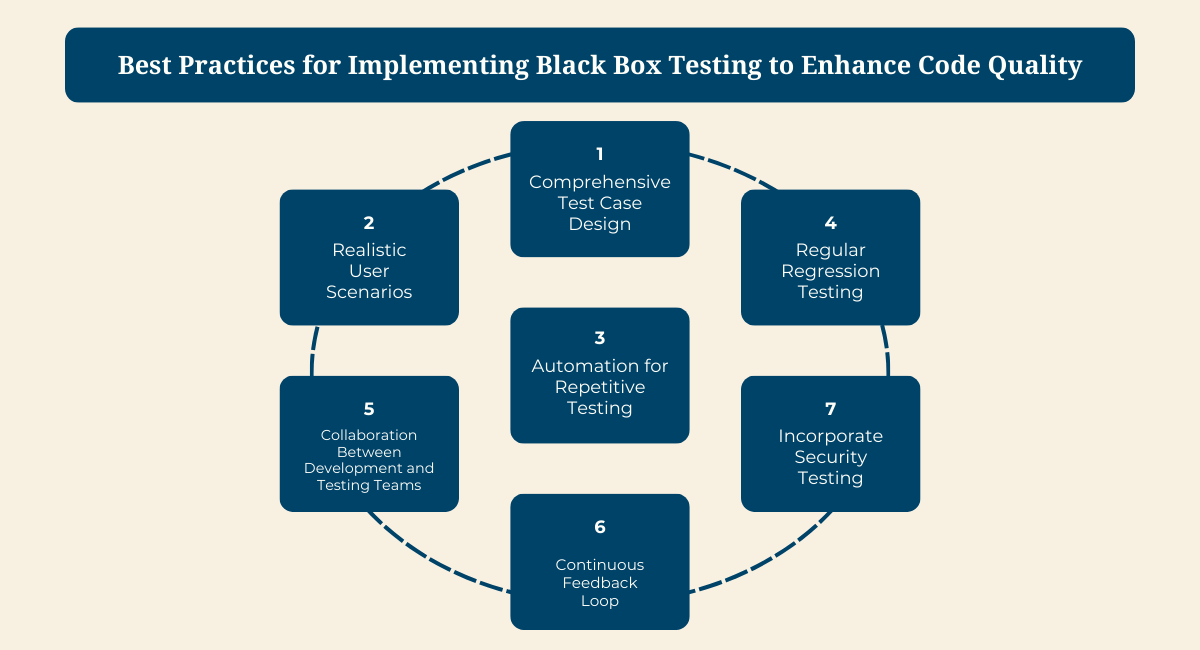
Comprehensive Test Case Design:
Design a diverse set of test cases that cover various functional scenarios, including standard and edge cases, to ensure complete coverage of the code.
Realistic User Scenarios:
Craft test scenarios that closely mimic real-world user interactions, helping to uncover issues related to usability, user experience, and overall system behaviour.
Automation for Repetitive Testing:
Implement test automation for repetitive and high-volume testing tasks. Automation allows for quicker and more frequent testing, enabling rapid feedback on code changes.
Regular Regression Testing:
Conduct regular regression testing as part of the Black Box testing process to ensure that new code changes do not introduce unintended side effects or regressions in existing functionalities.
Collaboration Between Development and Testing Teams:
Foster collaboration between development and testing teams to ensure a shared understanding of requirements, user expectations, and potential areas of improvement. This collaboration enhances the effectiveness of Black Box testing in identifying and addressing code quality issues.
Continuous Feedback Loop:
Establish a constant feedback loop between testing and development teams to facilitate the timely resolution of identified issues. This iterative process contributes to ongoing code quality improvement.
Incorporate Security Testing:
While not the primary focus, consider incorporating security testing within Black Box testing to identify and address potential security vulnerabilities early in the development process.
Enhancing Code Quality with White Box Testing
How White Box Testing Contributes to Overall Code Quality
White Box testing is instrumental in improving overall code quality by providing insights into the internal structure, logic, and functionality of the software. Its contributions extend beyond identifying coding errors to encompass areas such as code optimization, security fortification, and adherence to coding standards. Here's how White Box testing contributes to code quality:
Early Detection of Coding Errors:
White Box testing allows for a thorough examination of the code, enabling the early detection and rectification of coding errors, logical flaws, and other issues that may compromise the software's reliability.
Optimization for Performance:
By analyzing the internal code, White Box testing can identify performance bottlenecks, inefficient algorithms, and memory leaks. This information empowers developers to optimize the code for better performance and resource utilization.
Security Vulnerability Identification:
White Box testing is effective in identifying potential security vulnerabilities by scrutinizing the code for weaknesses and possible exploits. This proactive approach enhances the overall security of the software.
Adherence to Coding Standards:
White Box testing ensures that the code follows established coding standards, conventions, and best practices. This contributes to code maintainability, readability, and overall consistency.
Practical Unit Testing:
White Box testing is particularly beneficial for unit testing, allowing developers to validate the correctness of individual functions, methods, or modules in isolation. This ensures that each component functions as intended before integration.
Case Studies or Examples Showcasing Successful Code Improvements with White Box Testing
Web Application Security Enhancement:
White Box testing of a web application revealed vulnerabilities in the authentication system. The findings led to improvements in code logic, strengthening user authentication processes and enhancing overall security.
Algorithm Optimization in Financial Software:
White Box testing of financial software identified inefficiencies in complex calculation algorithms. Developers were able to optimize the algorithms, resulting in improved performance and more accurate financial calculations.
Healthcare Data Integrity Assurance:
White Box testing of a healthcare information system uncovered issues related to data validation and integrity. The code was revised to enforce stricter data validation rules, ensuring the accuracy and reliability of patient information.
Best Practices for Implementing White Box Testing to Enhance Code Quality
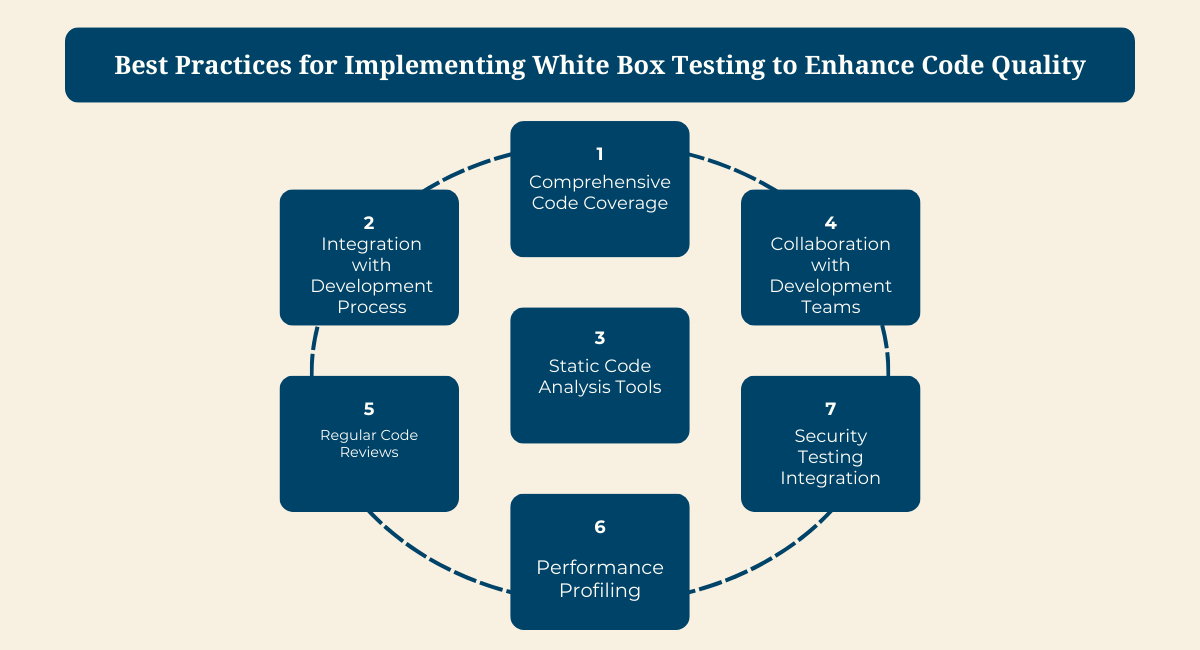
Comprehensive Code Coverage:
Design test cases to achieve comprehensive code coverage, including different paths, conditions, and branches within the codebase. This ensures that all aspects of the code are thoroughly tested.
Integration with Development Process:
Integrate White Box testing seamlessly into the development process, allowing for continuous testing and early detection of issues. This integration facilitates a more agile and responsive development environment.
Static Code Analysis Tools:
Utilize static code analysis tools to identify potential issues in the codebase automatically. These tools can assist in locating code smells, security vulnerabilities, and adherence to coding standards.
Collaboration with Development Teams:
Foster collaboration between testing and development teams to facilitate a shared understanding of code expectations, design patterns, and architectural considerations. This collaboration enhances the effectiveness of White Box testing.
Regular Code Reviews:
Conduct regular code reviews as part of the White Box testing process, involving both developers and testers. Code reviews provide an additional layer of scrutiny and promote knowledge sharing within the team.
Performance Profiling:
Use performance profiling tools during White Box testing to identify areas of the code that may impact system performance. This information can guide developers in optimizing critical components.
Security Testing Integration:
While primarily focused on functionality, integrate security testing practices within White Box testing to identify and address potential security vulnerabilities.
User Experience Considerations in Testing Strategies
Importance of Considering User Experience in the Testing Process
The user experience (UX) is a critical aspect of software development, directly influencing user satisfaction, adoption, and overall success of an application. Considering UX in the testing process is essential for several reasons:
- User Satisfaction: Testing that incorporates user experience considerations ensures that the software meets the expectations and preferences of end-users, contributing to higher levels of satisfaction.
- Identifying Usability Issues: By simulating real-world user interactions, testing can uncover usability issues, such as confusing navigation, unclear instructions, or non-intuitive design elements, helping to enhance the overall usability of the software.
- Reducing User Frustration: Rigorous testing focused on user experience helps identify and address issues that may cause frustration, annoyance, or confusion among users, leading to a more positive interaction with the software.
- Competitive Advantage: Applications with superior user experiences have a competitive edge in the market. Considering UX in testing is crucial for ensuring that the software stands out among competitors and meets user expectations.
- Brand Perception: A positive user experience contributes to a positive perception of the brand. Testing strategies that prioritize UX help in building and maintaining a favorable brand image.
How Black Box and White Box Testing Impact User Experience Differently
Black Box Testing and User Experience:
- User-Centric Focus: Black Box testing, being focused on external behaviour, inherently considers the user perspective. It assesses how users interact with the application without delving into the internal code.
- Real-World Scenarios: By simulating real-world scenarios and user interactions, Black Box testing helps identify issues related to user interfaces, navigation, and overall usability.
- Holistic Evaluation: Black Box testing evaluates the software as a whole, providing insights into how different components and features interact to create a seamless user experience.
White Box Testing and User Experience:
-
- Internal Code Evaluation: While White Box testing primarily examines the internal code, its impact on user experience is indirect. It helps ensure that the internal logic and functionality are sound, indirectly contributing to a positive user experience.
- Performance Optimization: White Box testing can identify and rectify performance bottlenecks, contributing to smoother interactions and improved responsiveness, positively impacting user experience.
- Security Fortification: White Box testing addresses security concerns, safeguarding user data and privacy. This, in turn, contributes to user trust and confidence in the application.
Balancing Code Quality Improvements with Positive User Experiences
Balancing code quality improvements with positive user experiences is crucial for delivering software that not only functions well but is also enjoyable and intuitive for users. Here are strategies to achieve this balance:
- Cross-functional collaboration: Foster collaboration between development, testing, and UX design teams. By working together, these teams can align priorities and ensure that code improvements also enhance the overall user experience.
- User-Centric Test Cases: Design test cases for both Black Box and White Box testing that prioritize user scenarios. This ensures that the testing process captures issues that directly impact the end-user experience.
- Usability Testing: Conduct dedicated usability testing sessions to evaluate the application from the user's perspective. This involves real users interacting with the software to identify any issues related to navigation, interface design, and overall user satisfaction.
- Iterative Feedback Loop: Establish an iterative feedback loop where user feedback is collected continuously. This feedback loop helps in refining both code quality and user experience over successive iterations.
- Performance Monitoring: Implement tools for performance monitoring to track how code changes impact the application's performance in real-world usage. This ensures that code optimizations do not inadvertently lead to negative user experiences.
- User-Centric Metrics: Define and measure user-centric metrics, such as user satisfaction scores, task completion times, and error rates. These metrics provide quantifiable indicators of how code changes impact the user experience.
- User Persona Considerations: Develop and consider user personas throughout the testing process. This helps ensure that the software aligns with the needs, preferences, and expectations of the target audience.
Choosing the Right Strategy: When to Use Black Box vs. White Box Testing
Factors Influencing the Choice Between Black Box and White Box Testing
The selection between Black Box and White Box testing depends on various factors, each influencing the testing strategy in different ways. Some key factors include:
Level of Access to Source Code:
-
- Black Box Testing: Suitable when source code access is unavailable or when the focus is on testing the application's external behaviour.
- White Box Testing: Appropriate when access to the source code is available, allowing for an in-depth examination of the internal logic and structure.
Testing Objectives:
-
- Black Box Testing: Ideal for validating functionality, user experience, and adherence to requirements without delving into the internal code.
- White Box Testing: More effective for identifying coding errors security vulnerabilities, and optimizing code performance.
Project Stage:
-
- Black Box Testing: Often applied in later stages of development, such as system testing and acceptance testing, focusing on the overall system behaviour.
- White Box Testing: Commonly used in early stages, including unit testing and integration testing, to assess individual components and code pathways.
Testing Resources and Skills:
-
- Black Box Testing: Accessible to non-technical testers or those without detailed knowledge of the internal code, making it suitable for a broader range of team members.
- White Box Testing: Requires a deep understanding of the internal code, often performed by developers or testers with technical expertise.
Project Requirements:
-
- Black Box Testing: Beneficial when the emphasis is on validating external requirements, ensuring user satisfaction, and identifying functional issues.
- White Box Testing: Valuable when there is a need to verify internal code quality, optimize performance, and address security concerns.
Scenarios Where a Combination of Both Strategies May Be Beneficial
In many cases, employing a combination of Black Box and White Box testing, known as Grey Box testing, can provide a more comprehensive and balanced testing approach. Some scenarios where a hybrid approach is beneficial include:
Integration Testing:
- Black Box Testing: Evaluates the overall system behaviour without examining internal code interactions.
- White Box Testing: Assesses specific code interactions and data flows between integrated components.
Security Testing:
- Black Box Testing: Identifies security vulnerabilities from an external perspective.
- White Box Testing: Analyzes the code for potential security flaws, ensuring a more thorough security assessment.
Performance Testing:
- Black Box Testing: Evaluates system performance under various user scenarios.
- White Box Testing: Identifies and optimizes code for performance bottlenecks and resource utilization.
User-Centric Testing:
- Black Box Testing: Focuses on user experience, usability, and overall satisfaction.
- White Box Testing: Ensures that the internal code aligns with user-centric objectives, optimizing code for better user interactions.
Considering Project Requirements, Goals, and Constraints in the Decision-Making Process
- Project Requirements: Assess the project's specific testing requirements, including functional validation, user satisfaction, security, and performance considerations.
- Project Goals: Define overarching goals such as delivering a user-friendly application, optimizing code for performance, ensuring security, or meeting specific regulatory requirements.
- Constraints and Limitations: Consider constraints such as time, budget, and resource availability when choosing a testing strategy. Black Box testing may be more feasible in situations where detailed code access or technical expertise is limited.
- Regulatory Compliance: If the project requires adherence to specific regulatory standards, White Box testing may be essential to ensure that the internal code meets compliance requirements.
- Application Complexity: Evaluate the complexity of the application. For more straightforward applications, Black Box testing may suffice, while complex systems may benefit from the additional insights provided by White Box testing.
- Team Expertise: Consider the expertise of the testing team. If the team has strong technical skills, White Box testing may be more viable; otherwise, Black Box testing might be a more accessible option.
- Risk Assessment: Identify potential risks associated with the project, such as security vulnerabilities, critical functionalities, or user experience issues. Tailor the testing strategy to mitigate these risks effectively.
Tools and Technologies for Effective Testing
Overview of Popular Tools for Black Box Testing
Selenium:
Type: Automation
Description: Selenium is a widely used open-source tool for automating web browsers. It supports multiple programming languages and allows testers to write scripts for functional testing of web applications.
Appium:
Type: Automation
Description: Appium is an open-source tool for automating mobile applications on Android and iOS platforms. It allows for cross-platform mobile testing using various programming languages.
JIRA:
Type: Test Management
Description: JIRA, developed by Atlassian, is a popular project management and issue-tracking tool. It includes test management features that facilitate the planning, execution, and tracking of test cases.
Postman:
Type: API Testing
Description: Postman is a versatile API testing tool that allows developers and testers to design, test, and document APIs. It simplifies the process of sending requests and inspecting responses.
TestRail:
Type: Test Management
Description: TestRail is a test management tool that helps teams organize and manage test cases, plan test runs, and track test results. It integrates with various testing and development tools.
Overview of Popular Tools for White Box Testing
JUnit:
Type: Unit Testing
Description: JUnit is a widely used testing framework for Java applications. It facilitates the creation and execution of unit tests to ensure individual units of code function correctly.
JUnit Jupiter (JUnit 5):
Type: Unit Testing
Description: JUnit Jupiter is the next generation of JUnit and is designed to address limitations in previous versions. It provides improved features for testing in Java applications.
JUnit Test Suites:
Type: Test Organization
Description: JUnit Test Suites allow the grouping of test cases into suites, enabling the execution of multiple tests in a specified order. This is useful for organizing and managing tests efficiently.
SonarQube:
Type: Static Analysis
Description: SonarQube is a platform for continuous inspection of code quality. It performs static analysis to identify code smells, bugs, and security vulnerabilities, contributing to code quality improvement.
OWASP ZAP (Zed Attack Proxy):
Type: Security Testing
Description: OWASP ZAP is an open-source security testing tool for finding vulnerabilities in web applications during development. It helps identify security issues such as cross-site scripting and SQL injection.
Integration Possibilities and Considerations for a Comprehensive Testing Approach
- Test Automation Frameworks: Integrate automation tools like Selenium or Appium with continuous integration (CI) systems such as Jenkins or Travis CI for seamless execution of automated tests during the development process.
- Version Control Systems: Utilize version control systems like Git to manage and version test scripts, ensuring that testing artifacts are aligned with the codebase.
- API Testing Integration: Integrate API testing tools like Postman with CI/CD pipelines to automate the testing of APIs as part of the development workflow.
- Continuous Inspection: Incorporate tools like SonarQube into CI/CD pipelines to perform a constant inspection of code quality and identify issues early in the development process.
- Test Management Integration: Integrate test management tools like JIRA or TestRail with other testing tools and frameworks for better organization, execution, and tracking of test cases.
- Security Testing Automation: Automate security testing using tools like OWASP ZAP within CI/CD pipelines to identify and remediate security vulnerabilities promptly.
- Reporting and Monitoring Tools: Use reporting tools such as Extent Reports or Allure for generating comprehensive test reports.
Improve Quality
Achieving high-quality software requires a balanced approach that encompasses both code quality and user experience. While Black Box testing ensures that the software meets functional requirements and provides a positive user experience, White Box testing delves into the internal code to optimize performance, identify security vulnerabilities, and uphold coding standards.
The synergy of these testing strategies contributes to a comprehensive quality assurance process that enhances both the functionality and internal robustness of the software. Maintaining this balance is essential for delivering software that not only meets technical standards but also delights users with a seamless, intuitive, and enjoyable experience.
A user-centric approach, combined with rigorous testing of internal code quality, ensures that software not only functions flawlessly but also aligns with user expectations, resulting in increased user satisfaction and market success.
You may also be interested in Application Lifecycle Management (ALM): What It Is and Why You Need It.
Book a Demo and experience ContextQA testing tool in action with a complimentary, no-obligation session tailored to your business needs.
We make it easy to get started with the ContextQA tool: Start Free Trial.
